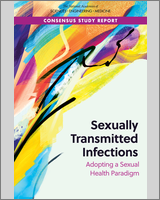From: 5, Intersection of HIV and STIs

Sexually Transmitted Infections: Adopting a Sexual Health Paradigm.
National Academies of Sciences, Engineering, and Medicine;Health and Medicine Division;Board on Population Health and Public Health Practice;Committee on Prevention and Control of Sexually Transmitted Infections in the United States; Crowley JS, Geller AB, Vermund SH, editors.
Washington (DC): National Academies Press (US); 2021 Mar 24.
Copyright 2021 by the National Academy of Sciences. All rights reserved.
NCBI Bookshelf. A service of the National Library of Medicine, National Institutes of Health.
